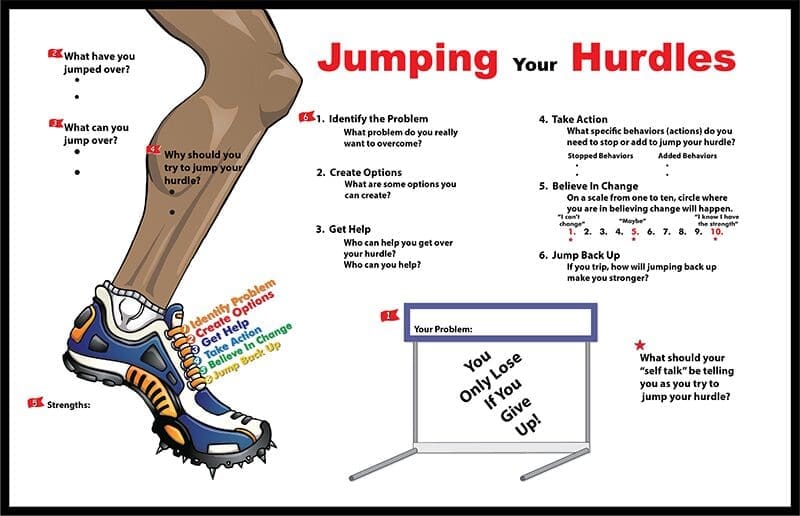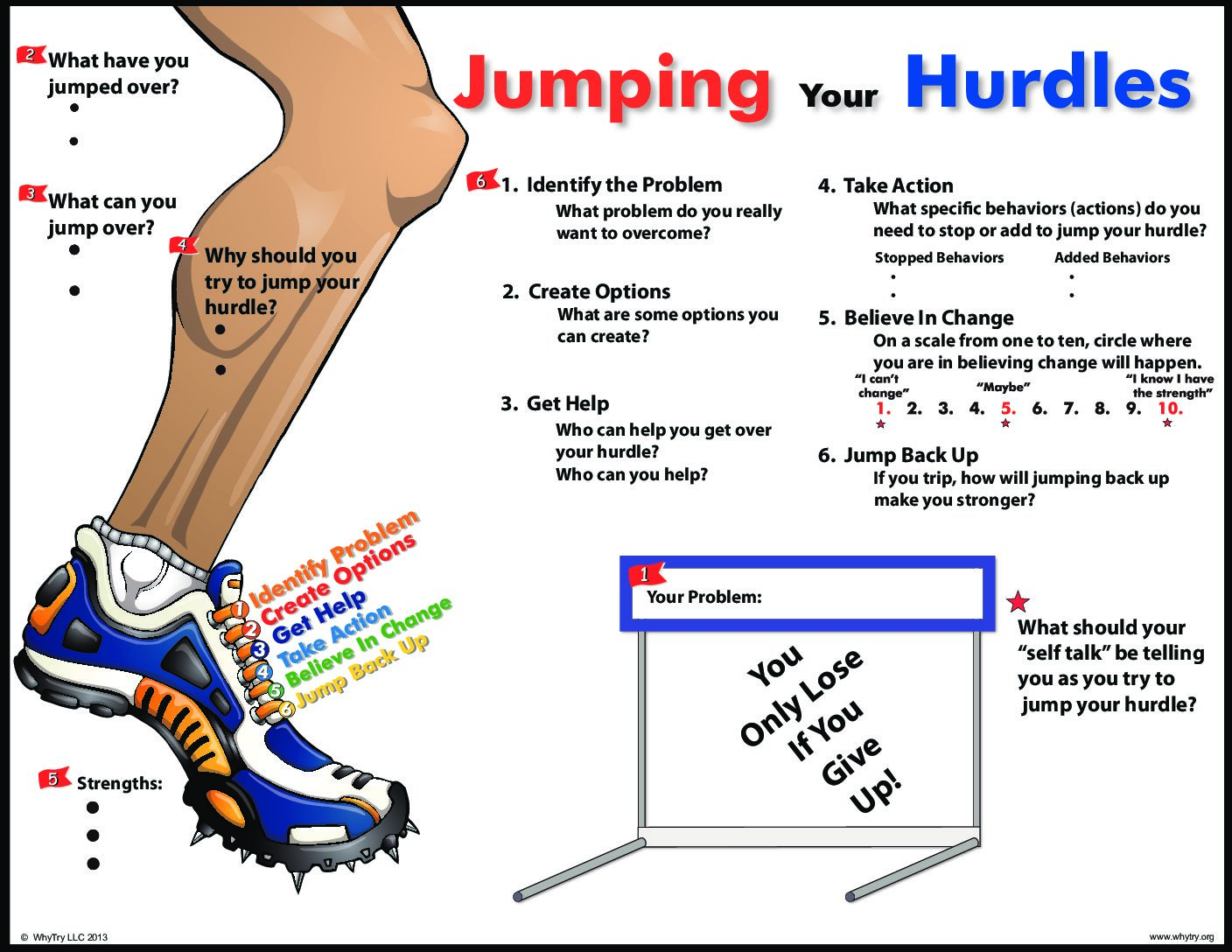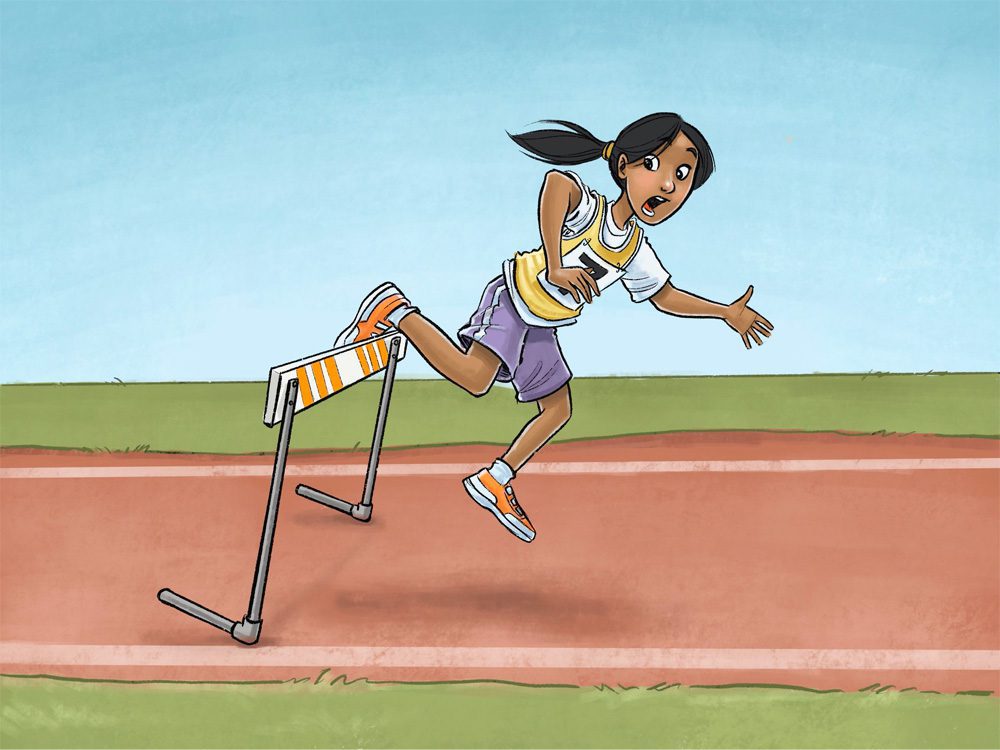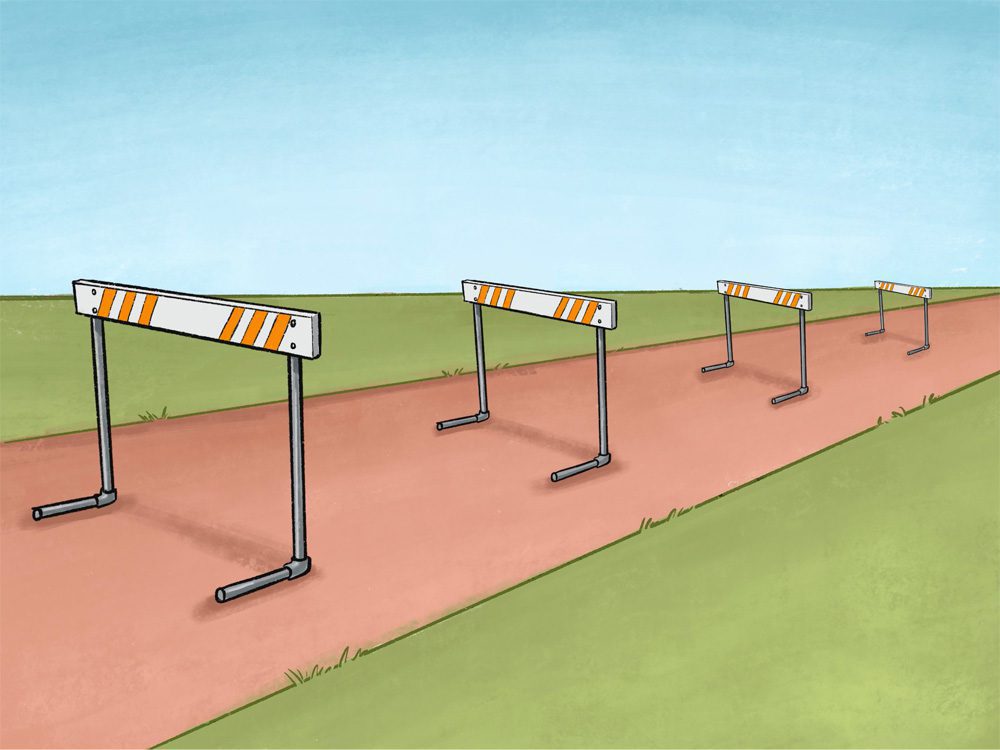Problem-Solving Sample Lesson
Jumping Hurdles
Get Started
With the Lesson Plan PDF
Problem Solving
Jumping Hurdles
Explain to students that sometimes in life we experience problems that make it hard for us to be successful at something. Problems can be frustrating and can cause us to shut down and give up when we lose our motivation. Some people are really good at problem-solving. Do you know anyone who is a good problem solver? What makes them so good at solving problems? (Maybe you can share an example of someone that you know who is a good problem solver and explain why)
Say: Did you know that I know a secret about problem-solving? I know what makes someone good at problem-solving, and it’s not just because they are really smart. Today I want to teach you the secret to being good at problem solving and it begins with this game called 15 Pencils.

Jumping Hurdles Lesson Elements
Activity: 15 Pencils
Visual Metaphor Walk-through: Jumping Hurdles
Visual Metaphor: Tripping on a hurdle
VIdeo Clip: The Hurdler
Jumping Hurdles Vocabulary
- Effort
- Keep trying
- Giving up
- Hurdles / Problems
Jumping Hurdles Learner Objectives
- I can recognize we all have hurdles (problems) in our life.
- I understand the importance of trying and not giving up after tripping on a hurdle.
- I can identify the steps to problem solving.
Activity 15 Pencils

Introduction:
When we use lucky guesses to get through life, it can become difficult to overcome problems and reach our goals. Successful people, on the other hand, follow a “model of success” that makes it easier for them to consistently jump the hurdles of life. This activity will demonstrate that knowing the “pattern” or formula for success makes jumping hurdles possible.
Details:
- Space: Any
- Activity Type: Object Lesson
- Grades: 3-12
- Group Size: Any
- Time: 5-10 minutes
Materials:
- Any combination of pencils, pens, or markers – 15 total
- 1 overhead projector, Elmo, or table.
- (Optional) Use the slide in the presentation deck
Instructions:
Before you begin, spread the writing utensils across your display surface so they are visible to all. Two people play this game at a time, taking turns picking up one, two, or three writing utensils. To win, the other player must be the last one to pick up a utensil.
There is a secret to winning this game. You, the instructor, will go first, taking two writing utensils. The other player will take one, two, or three. On your next turn, take enough to equal six utensils between the two of you. When the opposite player goes again, take enough to equal ten between the two of you, and on your final turn, take enough utensils to leave the opposite player with one.
Be boastful and confident in your ability to win this game before explaining the rules and beginning play. The other player may begin, as long as you adhere to the “two, six, and ten” rule. For example, if the other player goes first and takes one, you need to take one to meet the “two” rule. You may play several rounds, challenging a different member of the class each time. If someone does beat you once, explain that they were lucky, but that true achievement means repeating success again and again. Then challenge the player to see if they are LUCKY enough to win again.
Once they understand the pattern or are sufficiently frustrated, ask them, “How do you win this activity?” Explain that there is a system or pattern for everything.
Processing Questions:
- What made this game difficult?
- Were you able to figure out the pattern? If so, how?
- How did you feel when class members continued to lose?
- How does the pattern in this game apply to the formula for jumping hurdles?
- Which will help us solve our problems or jump our hurdles more: waiting to see
Metaphor Walkthrough
10 Minutes
Whether you are using the Powerpoint Tool, projecting the metaphor, or providing individual copies, follow the sequence annotated by the red flags on the metaphor. It will be a guide to help you walk the students through the Metaphor:

Metaphor Setup:
Explain to students that sometimes in life we have hurdles that we feel we can’t jump over. This metaphor is going to show you today how you can. Show the visual analogy, and tell students that the hurdle in this picture represents problems or challenges we face in life. Ask the question: why do we use a hurdle to represent problems or challenges in our life? Why don’t we use another object like a boulder, wall, or even a hoop we jump through (another common saying)? What makes a hurdle such a great metaphor to the problems we have to solve in life?
Answers may include:
- It is naturally part of a race, or part of the process.
- When you trip or knock it down (fail), you keep going. It is not over.
- You can learn to get better and better at jumping hurdles.
- The hurdle is possible to jump over.
Relate the Jumping Hurdles metaphor to the Reality Ride by pointing out the Harder-But-Worth-It track. Take note of the hills on the track and say even when we get on the harder but worth it track, problems will come along, and we have to learn how to jump those problems. Say before I teach you hot to solve your problems, let’s answer a few questions.
Discussion Point #1:
Prompt students to identify a problem they need to solve. They may need to brainstorm a little bit, but invite them to think of a problem they believe they could solve. Perhaps it is earning enough money for something, or solving a problem with a friend or family member. Maybe it is trying to figure out how to avoid being late to class. Students should write down the problem they choose on the hurdle on the metaphor page (if you are giving each student a handout).

Discussion Point #2 :
Storytelling
Say: I want all of you to write down one or two achievements or accomplishments you are proud of? What are some things you have done that you are proud of? Give students about 30 seconds to write this down. Then say: Now I want you to write down two hurdles you had to jump, or problems you had to solve in order to reach that accomplishment or do that thing. Take a moment and share a story of something you have accomplished in life and a few hurdles you had to jump over in order to accomplish it. This is a great moment for you to share about your successes as well as inspire your students as well. Follow the effective indicators from the tutorial on storytelling.
Give a few students the opportunity to either share with the class or everyone to share with a peer their examples. Afterward, make the connection that you are not learning how to cross the finish line (their accomplishments) but rather to help them learn how to jump hurdles along the way!
Discussion Point #3:
Briefly explain that sometimes we try to tackle challenges or problems that are beyond our ability or that are too difficult for us right now. Before you begin the process of jumping that hurdle, you may want to ask yourself if this is a problem that you can realistically overcome. Have students identify hurdles they believe they could jump over and to really ask themselves if the problem they wrote down originally in discussion point #1 is possible. They can change it if they’d like.
Discussion Point #4:
Invite students to reflect on this point with regards to the problem they identified on the hurdle. Invite a few students to share with the class the answer to this discussion point.:
Discussion Point #5:
Explain how important it is to believe in yourself and in order to believe in yourself, you have to know what you are good at. Invite students to identify strengths that will help them jump hurdles throughout their life. Explain how athletes have to develop strengths as well in order to do what they do.
Metaphor Walkthrough
Continued



Discussion Point #6
The six steps
Step One:
What problem do you really want to overcome? Discuss with students how you’ve already had them identify a problem, but when we are actually going through the process you have to ask yourself if you really want to jump that hurdle.
Discuss the following as you feel necessary as the teacher:
Unless they truly desire to jump their hurdle, overcoming it will be even more difficult. Allow for a wide variety of problems, because different people view problems differently. They need to choose a problem over which they have some control and in which their own actions can make a difference. They can’t overcome someone else’s problem for them. For example, they might identify the problem that they feel bad because a friend is failing or using drugs. Although they can help the friend, they can’t jump that friend’s hurdle for them. Parents divorcing is another problem over which students have no control.
Step Two:
What are some options I can create? Explain this is the brainstorming step. If students are having a hard time, help students understand that if a problem seems impossible to overcome, they probably don’t know all of the possible options. Warn students that discouragement is one of the biggest obstacles in overcoming problems. One of the best ways to deal with discouragement is to identify as many options as we can. The word “create” is important because options don’t always fall in our laps. Often we must work and use our creativity. Ask: If we can’t think of any options or ideas, what can we do? (Find help from other people) Prompt the students to brainstorm around the problem they identified in step one.
Step Three:
Who can help me jump my hurdle? Explain getting help from others is a great way to create more options and to see solutions that we are blinded to because we are too close to the problem. Many people have already overcome the hurdles that we are trying to get over. Remind students to be willing to seek out and accept help. Invite students to identify other people who have jumped the same hurdle they are trying to jump.
Step Four:
Take Action. Explain this is the action plan. Here you will use the ideas you’ve generated to identify actions you need to start doing and actions you need to stop in order to solve the problem. Prompt the students to create an action plan around the problem they identified in step one.
Step Five:
Believe in Change. Invite students to answer this question for themselves. Say: Based on the action plan you’ve created and the problem you have identified. How much do you believe in change? How much do you believe you can jump this hurdle. Have them look at the chart from 1-10 and circle the number or identify the number they would rate their belief in themselves. Explain to students that their belief in themselves is the most important strength they can have. Encourage them to remember positive changes they have made in the past and believe in their abilities. This is a great moment to share the quote: if you believe you can or if you believe you can’t, you’re right! (Henry Ford) Ask the students what they believe that quote means. Side note: This is a great moment to share the point on the metaphor where it talks about what our self-talk should be as we try and jump the hurdle. Ask students what they believe athletes are thinking in the middle of a race or event? You may even want to link this back to the Motivation Formula lesson on positive self-talk.
Step Six:
Jump Back Up: Ask the question: If you trip, how will jumping back up make you stronger?
Jumping Hurdles Metaphor Walkthrough


Ask the following questions:
- What’s happening in this image?
- What should a runner do during a race if they stumble over a hurdle?
- What might tripping over this hurdle represent (moments we’ve failed, made mistakes, or been unsuccessful in solving problems)?
Using Video
Let’s watch a video together of a runner in a race:
Show video below or from the link in our toolkit: Girl doesn’t give up after falling during hurdle race
Processing Questions:
- What happened in that video?
- How did the girl respond after she fell down?
- What things do you think helped her get back up after she fell?
- Do we ever fall or make mistakes in life?
- What can we do to get back up and keep trying?
- Why is it important to get back up if we fall down or make a mistake?
Visual Metaphor: Multiple Hurdles


Show Next Image of multiple hurdles:
Processing Questions:
- What are some things we can learn from making mistakes or falling? (How to do things better or different)
- In a race does a runner just have to jump over one hurdle or are there a lot?
- In life will there always be hurdles in our path?
- What are some future challenges or hurdles we might face? (Going to high school, getting a job, etc.)